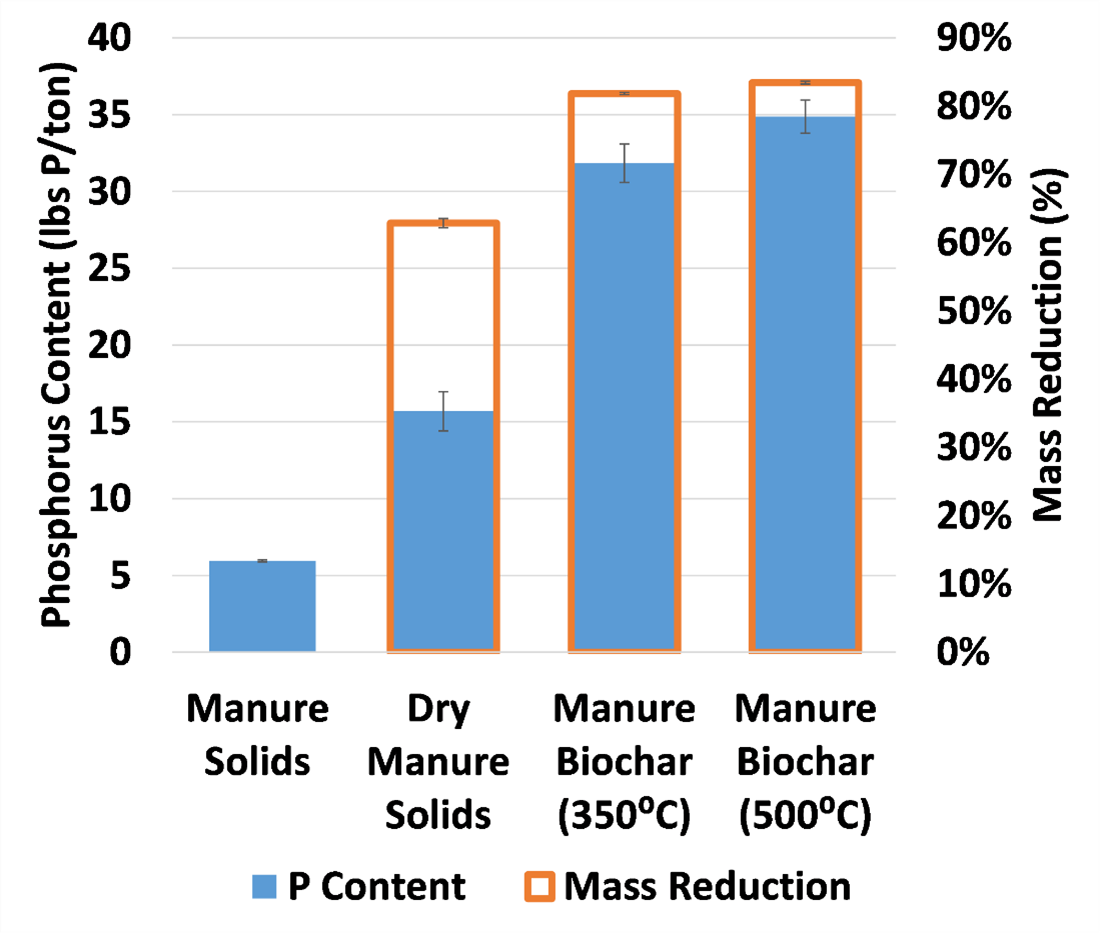Purpose
Manure produced at livestock facilities contains plant essential nutrients, such as nitrogen and phosphorus, which is typically land applied as a fertilizer source for crops near where it is generated. However, in areas of high livestock density, due to the imbalance of nitrogen and phosphorus in manure compared to crop requirements, soil phosphorus concentrations have increased. This has resulted in soil phosphorus legacy issues throughout the Midwest, contributing to water quality issues in surrounding waterways. To reduce phosphorus application near livestock facilities, advanced manure management systems are needed to separate and concentrate manure nutrients, particularly phosphorus, to expand transport distances. In this study, we investigated converting separated anaerobically digested manure solids into biochar through pyrolysis to densify manure nutrients. In addition, we examined the availability of phosphorus from manure derived biochar in a soil incubation study to evaluate its fertilizer potential.
What Did We Do
We collected anaerobically digested manure solids from a screw press separator at a local dairy facility. Manure solids were dried and converted to biochar at two different temperatures (662°F and 932°F). The mass of the dried manure and biochar were determined and samples analyzed for total nitrogen, total phosphorus, and available phosphorus to evaluate densification of manure nutrients.
We additionally evaluated nutrient availability of manure solids and biochar in a soil incubation study. In the study manure solids and biochar were applied at equal agronomic phosphorus rates to two different soil textures (loam and sandy loam). Soils were then incubated for 182 days with samples collected and analyzed Every week for four weeks throughout the period to evaluate phosphorus release over time.
What Have We Learned
We found that converting manure solids to biochar is an effective method for reducing manure mass while retaining the original manure phosphorus content (as shown in Figure 1). However, manure derived biochar had lower available phosphorus following pyrolysis than the original separated manure solids, with the available P decreasing as the pyrolysis temperature increased.

During the soil incubation study, while soils with manure derived biochar application had lower available phosphorus at the start of the incubation period, within 28 days available soil phosphorus reached similar levels to those amended with separated manure solids in both soil textures. While nitrogen was applied at different rates, making comparisons difficult, there were minor changes in soil available nitrogen for manure derived biochar, suggesting no additional nitrogen availability during the incubation period.
Future Plans
We plan to further investigate manure derived biochar as a potential advanced manure processing pathway, by evaluating whether manure derived biochar can provide additional soil benefits, such as reducing nitrogen leaching when amended to agronomic soils and increasing crop yields in field studies.
Authors
Joseph R. Sanford, Assistant Professor and Wisconsin Dairy Innovation Hub Affiliate Researcher, School of Agriculture, University of Wisconsin-Platteville
sanfordj@uwplatt.edu
Additional Authors
Rebecca A. Larson, Associate Professor, Biological Systems Engineering, University of Wisconsin-Madison
Additional Information
Sanford, J., H. Aguirre-Villegas, R.A. Larson, M. Sharara, Z. Liu, & L. Schott. 2022. Biochar Production through Slow Pyrolysis of Animal Manure. University of Wisconsin-Extension, Publication No. A4192-006/AG919-06, I-01-2022.
Acknowledgements
This material is based on work that is supported by the National Institute of Food and Agriculture, U.S. Department of Agriculture, under award number 2017-67003-26055. Partial support was provided by the Wisconsin Dairy Innovation Hub. Any opinions, findings, conclusions, or recommendations expressed in this publication are those of the author(s) and do not necessarily reflect the view of the U.S. Department of Agriculture or Wisconsin Dairy Innovation Hub.
The authors are solely responsible for the content of these proceedings. The technical information does not necessarily reflect the official position of the sponsoring agencies or institutions represented by planning committee members, and inclusion and distribution herein does not constitute an endorsement of views expressed by the same. Printed materials included herein are not refereed publications. Citations should appear as follows. EXAMPLE: Authors. 2022. Title of presentation. Waste to Worth. Oregon, OH. April 18-22, 2022. URL of this page. Accessed on: today’s date.

